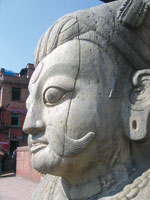|
|
| FLAKING OFF: The statue of Pratap, among the five pairs of stone figures guarding the Nyatapola (below) has developed a crack that could peel its face off. |
The Nyatapola temple in Bhaktapur is Nepal's tallest temple. It has withstood several major earthquakes that have struck Kathmandu Valley since it was built in the 17th century. Its brick walls and carved wooden eaves have survived the ravages of time.
But exposure to the elements over the centuries is taking its toll on the statue of Pratap, one of five pairs of stone figures that guard the staircase reaching up to the first floor.
Among the elephants, lions, griffins are the statues of Jaya and Pratap who were katuwals during the reign of Bhupatindra Malla. It is the beautifully detailed statue of Pratap that is now losing its face, its stone mask peeling off along a crack.
Pratap may lose his face tomorrow, or it may take another 10 years, but sooner or later, the face will flake off unless action is taken immediately. Similar damage to the other statues in Nyatapola, or indeed other temples in Kathmandu, can't be ruled out.
The temple was built in a record 100 days by King Bhupatindra. Thousands of Bhaktapuris toiled to drag the granite blocks from Chapagaun, 25km away.
 Written records show that the workers were paid Rs 18 for their labour, a generous amount in those days.
Written records show that the workers were paid Rs 18 for their labour, a generous amount in those days.
Nepali archaeologists now need to step in to protect the priceless architectural heritage that our ancestors bequeathed us. There is quite a bit of experience from Cambodia and Italy in restoring stone statues.
Pratap's statue shows a crack that started from the forehead now slicing cleanly across the face to the chin. A second crack has also developed in the nose area, but this and another one near the top of the head are not so serious yet.
The reasons for the cracks are the inherent weaknesses in the rock and exposure to the sun, rain, heat and cold. Lately, they could have been exacerbated by acid rain and urban air pollution.
We may not be able to stop the crack, but we can arrest its spread and save the face. A stitch in time may indeed save nine.
Sukra Sagar Shrestha is an archaeologist formerly with the Department of Archeology and lives in Kirtipur.
[email protected]



